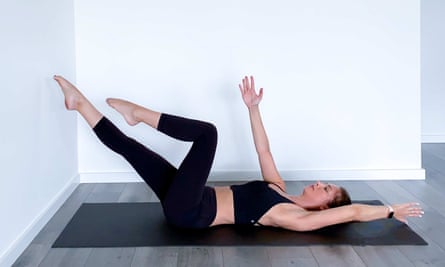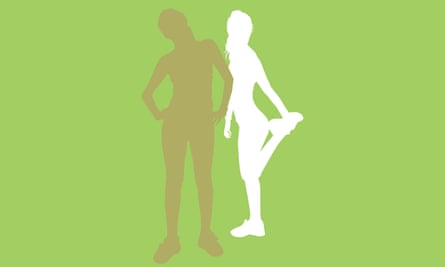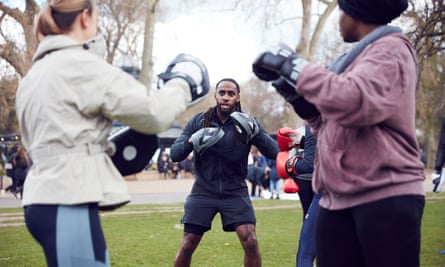
There is an idea that getting fit means expensive gym memberships and ludicrously priced leggings – this need not be the case. From alternatives to weights to finding a fitness family, personal trainers share their secrets to getting fit for free.
Move every day
Fitness is not “a bonus or luxury for your life”, says Devi Sridhar, the chair of global public health at the University of Edinburgh who qualified as a personal trainer in 2022. Instead, it is about “going back to basics, which is moving your body every single day and avoiding sedentary behaviour”.
Make sure your regime covers all bases
Sridhar takes what she calls a triangle approach to fitness: “The first is cardio, so you are getting your heart rate up.” Depending on your fitness level, this could be “walking briskly, jogging or doing sprints in the park”. Next up is strength training: “Push-ups, squats and lunges – basically things that work your muscles. Again, you can do this at home or you can do them in a park.” Finally, flexibility: “Making sure – and this is especially important for the lower back – that you are stretching your hip flexors and legs. You can find exercises on YouTube or other online free resources.”
Work out what sort of exercise suits you best
The success of a new fitness regime “depends on a person’s ability to sustain exercise and remain consistent”, says Zoe Mckenzie, a personal trainer and physiotherapist from Essex who lives in Wollongong, Australia, and runs the Actively Autoimmune community. “Attending a gym, a class or working with a fitness professional helps you to stay accountable and access support. Sometimes just the fact you are paying for something makes you commit. When exercising for free, you have to rely on other tools to help you stay engaged.” The best starting point for this, she says, is “trying to find something you are passionate about. Exercise isn’t a punishment or a chore.” What works for you “depends on your current fitness level”, she says. “Then you can look at what support you might need to help you with this and how you can access it for free.” Aside from the usual activities, Mckenzie recommends outdoor swimming, as long as it is done safely, and cycling, if you can access a bike freely or through an affordable hire scheme, as particularly enjoyable ways to keep fit inexpensively.
Figure out a suitable ‘dose’ of exercise
“A lot of people jump into doing too much, or going too hard, too soon,” says Mckenzie. “This often results in a boom and bust approach of doing lots, then burning out and doing nothing. Starting low and going slow is key to building up whatever activity you are doing.”
Find a way to keep yourself motivated
Make sure you are clear with yourself about the reasons you want to improve your fitness, says Mckenzie, and “any goals you want to work towards to help with your adherence to your new regime. Think about how you can make exercise a sustainable habit by planning it into your lifestyle. Look at ways to keep yourself accountable, such as methods to track your progress, or joining a support group or exercising with a friend – everyone is different, so find what would help you to enjoy exercise.”
Get a fitness buddy
Holly Davidson, a British personal trainer and the author of several fitness books who lives near Malmö in Sweden, agrees it is helpful to find a friend to get fit with. “Your friend can be your personal trainer,” she says. “If you agree, ‘We’re going to meet at a certain time and we’re going to do a workout,’ then it gives you more motivation to actually show up and get it done. Second, both of you are going to have ideas on what exercises you’re going to do.” It’s also more fun, she says: “You can have a chat and time goes quicker when you’re exercising with someone.” If there isn’t someone immediately obvious in your social circle, put your feelers out a bit wider, she suggests, and you will hopefully find a friend of a friend to get fit with.
Start the weekend with parkrun
If you can’t find a pal, there is a fantastic readymade family of fitness improvers at parkrun events, says Davidson. There are over 1,000 of these free 5k runs taking place at parks across the UK, and many more around the world. Running solo isn’t for everyone, she says, and this is the perfect way to start running with others, whatever your ability. “Parkrun is not competitive; it is very lighthearted. There are people walking it, doing it with buggies, and kids taking part. It is a really friendly environment.”
Walk absolutely everywhere
Walking is “totally underestimated”, says Davidson. “It is something that I really try to push for with clients, not only for the exercise and the ease of it – you don’t need any equipment, you can do it in your jeans and a pair of comfortable shoes – but it is really good for mental health as well. You can get some fresh air and listen to a podcast, music or the birds. It is a simple, mindless thing where you don’t have to plan it or think about what you’re doing – you can just go.”

Speed it up
“If you want to build up your cardiovascular fitness,” says Davidson, “then go for a brisk walk. If you’re not getting breathless, then find a hill and walk briskly up that and you’re going to really feel it a lot more.” Any walking, however slow, is better than none.
Embrace the home gym
If it is too difficult to get out, exercise at home, says Davidson. Just make sure you are focused. “It can be easy to want to put the washing on, do the washing up or get absorbed in your emails. Really try to give yourself 20 minutes to half an hour and not get distracted with the other things going on.” Have a dedicated mat, “so it’s not just on the carpet but feels like this is your space to work out. Obviously you can do a workout at home in your pyjamas, but I always find if you are in your workout gear you’re a bit more focused.”
Pick up a can of beans
“Everything in your house is potentially a piece of equipment,” says Javeno Mclean, a personal trainer and owner of J7 Community Health Centre in Blackley, north Manchester. “I’ve made people take off their shoes and use a shoe as a dumbbell. I’ve had people use a can of beans, use stairs to do dips and step-ups, use cushions on the sofa to help do glute bridges and press-ups. If you fill pots and pans with water, before you know it you’ve got something that has got a bit of weight in it and you can squat with that” – avoiding spilling if possible.

Make use of the best weight of all: the body itself
You don’t really need to own dumbbells, says Davidson: “There are so many exercises that can be very challenging without any weights: press-ups, planks and even a squat – you can slow the squat down, you can hold it at the bottom of the squat and you can add pulses.”
Focus on wellbeing rather than fitness
“Take a holistic approach to fitness and include nutrition and sleep,” says Glasgow-based personal trainer Alasdair Nicoll of the Fitness Group. “Making improvements to these will improve your fitness and can actually have a greater impact than exercise itself. Reducing body fat, gaining more energy and increasing lean muscle mass are all possible outcomes. Not only is investing in your sleep free, but improving on your nutrition could save you money – less takeaways and costly meal deals being replaced with nutrient-dense home-cooked meals.”
Get appy
Our Parks offers several apps that you can use at home for free, including Couch to Fitness. “Many of the world’s leading personal trainers have apps that come with free trials, such as Sweat and Joe Wicks’s the Body Coach,” says Nicoll. “Also try Daily Yoga for free yoga workouts.” Sridhar recommends the NHS’s Couch to 5k, which helps users to start running from scratch and build up the confidence to take part in a parkrun.
Join the online workout revolution
YouTube is an incredible resource for workout inspiration, says Mclean, but you need to search for someone whose “speech, energy, sense of humour and character” you click with, because it is a very personal thing, just like a real-life fitness instructor. Likewise, Instagram and TikTok have a wide array of personalities just waiting to get you fit, but this comes with a word of warning from Mckenzie to check their credentials: “Generally, people advising ‘this one exercise will cure your back pain’ tend not to be following evidence-based practice; neither are the people suggesting their method is ‘the only’ method, or promising unhealthy, fast weight loss.”
Find fitspo at the library
It may feel as retro as a 1980s aerobics video, but most libraries will stock or be able to order a range of books by fitness gurus, which are a “great source” of exercises and training plans to try, says Davidson. If you get out enough books, they can double up as a weight in a backpack, she adds.
Take the seven-minute challenge
Mclean offers free classes for older adults and people with disabilities at his gym. What advice does he have for those who don’t live near enough to access this? “Obviously, everyone’s not blessed with the same gifts,” he says, “but if you’ve got anything that can move, move it as much as you can. I think that is the first door that needs to be opened: the bravery to try.” He likes to challenge his older clients to play the seven-minute game, “where you set a timer and every seven minutes you stand up and go for a walk around the house, outside or upstairs if possible, then sit back down”.
Find a class
A local park is a great place to find free or affordable exercise classes, says Sridhar. “You can have a look online at what is offered there, such as outdoor bootcamps. While they may not be completely free, quite a few are just a couple of pounds, which is less than a coffee. Churches and community centres also offer classes such as yoga, many of which are run on a donation system. It is probably hard to find a class permanently free, but you can get one that’s low cost and run on a drop-in basis rather than expensive memberships.”

Get park fit
“When you exercise outside, the endorphin release is greater than exercising indoors, so you feel better for longer,” says the fitness coach and personal trainer Born Barikor. He knows all about this as 10 years ago he founded Our Parks, persuading councils to fund free outdoor classes, first in Walthamstow, east London, then all over England and Scotland in more than 300 parks. Sessions include everything from Hiit (high-intensity interval training) to box fit. “If you’re worried about attending,” says Barikor, “you can go and have a look – pretend that you’re walking around the park and see what it is like. There are no barriers to what we do: you can come and watch us for two weeks and build up the confidence to join in.”
Use your surroundings
If Our Parks classes aren’t available at your local park, you can request that sessions are offered there. In the meantime, there is much potential for using what is already in the park, says Barikor: “They have so much apparatus, such as green gyms or benches. You can do bench workouts, using them to do bench press-ups or mountain climbers.” You can also build up walking and running around trails or paths, he says. “Measure time or distance, and then say: ‘OK, today I’ve walked for five minutes or 20 minutes’ – depending on what your fitness level is – ‘and it took me this amount of time.’ Then you can start to make it a regular habit and turn that walk into a fast walk or a power walk. Then, if you want, you can turn it into a jog and use a lamp-post or tree as a marker for running for a certain distance then walking again.”
If you invest in one affordable thing to help your fitness journey, make it …
Mclean: “A resistance band. It’s so versatile – you can work out the whole body with it.”
Nicoll: “A kettlebell because of its suitability for different exercises that will help you build up your core strength.”
Sridhar: “Trainers. If you don’t have proper trainers, your knees can go; especially with running or jumping, you need to have proper cushioning. A lot of trainers are available cheaply in outlet shops online.”
Barikor: “It can be done for free – all you need is time. Invest in a slot in your day, whether that is half an hour or 10 minutes. It will benefit you not only physically but mentally as well.”



